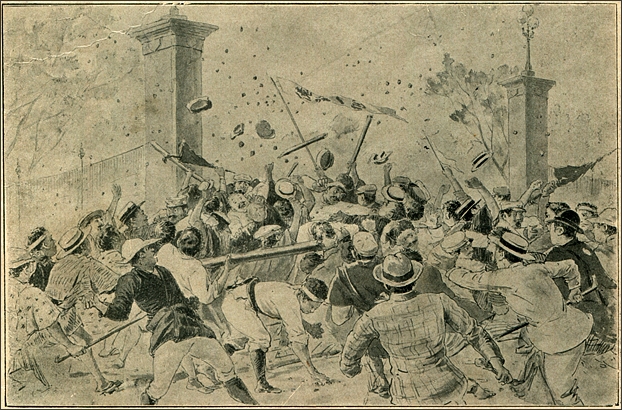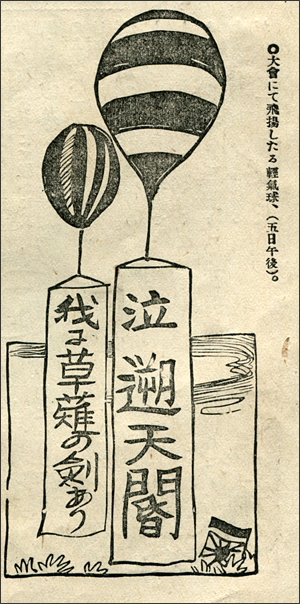| |
CHALLENGING THE STATE
In 1873, Fukuzawa Yukichi observed in one of his most famous books, An Outline of Civilization, that “Japan has a government but no nation.” The Japanese people, that is, had no sense of themselves as kokumin. This was a neologism that Fukuzawa—the most important intellectual of his day and a brilliant wordsmith—defined in this text by inserting the phonetic Japanese pronunciation of “nation” (nēshon) alongside the characters for kokumin.
By the time of the Hibiya Riot, these once parochial or apolitical people, or their children, showed themselves to be active members of the nation and supporters of empire. They were anxious to voice their opinions on matters of foreign and domestic policy and insistent they be respected. Much of the apparatus of the modern nation had initially been imposed on them from on high, including mass compulsory education and a military draft in the 1870s. The Meiji constitution was written in secret and promulgated in 1889 as a gift of the emperor to his loyal subjects. The state promulgated a new civil code nationwide in the 1890s.
In all these steps, the balance between the obligations and the rights of the people tilted clearly toward the duties of subjects to be loyal to the state. Hibiya Park itself was designed and built by the government on a Western model at the turn of the century, with the understanding that modern cities required grand public spaces. It opened in 1903, just two years before the riot. It was first given extensive use during the Russo-Japanese War to celebrate war victories. The project of nation building was in these ways undertaken by the state with the intention of bringing into being a loyal body of kokumin, or people of the new nation. As Japan established itself as an imperial power in the decade spanning the turn of the 20th century, this project seemed to be working more or less as its elite architects had intended.
The irony made clear in the course of the riot was that the Meiji state if anything had succeeded too well. In matters political the people had views of their own, which they were more than willing to express in word and deed. They took various steps to appropriate public and imperial spaces, captured in some cases uniquely in the pages of The Tokyo Riot Graphic. In their anger at being excluded, the crowd asserted that Hibiya Park belonged to the people, not the state. This stance is dramatically rendered in a drawing of a stone-throwing melee at the entrance to the park “which followed in consequence of the attempt of the police to prevent the ingress of the crowd into Hibiya Park.” The perspective of this illustration—sketched from the side of what the caption writer in the Japanese language caption termed “Tokyo citizens” as they confronted the state’s forces or order—suggests that the artist supported the people’s claim to the park.
|
|
 |
| |
A stone-throwing crowd storms the gates of Hibiya Park, which had been blockaded by the police. The artist’s perspective suggests he supported the protestors’ assertion that such public space belonged to the people rather than to the state.
English caption: “The Great Disturbances in Tokyo: ...riotous scene which followed in consequence of the attempt of the police to prevent the ingress of the crowd into Hibiya Park.”
[trg007b]
|
|
| |
Among the most unusual depictions of such acts of appropriation are two photographs of remarkably calm moments at key places during the three days of the riot. We can be thankful and impressed that the photographer found these scenes worthy of recording and that editor Kunikida found them worthy of publishing.
The first photo, as the English caption tells us, shows “citizens angling in Ichigaya moat, where it is usually prohibited.” The Ichigaya moat was (and to this day remains) a remnant of the outer moat surrounding what was once the shogun’s castle at the center of Edo, which by 1905 had for several decades been the imperial palace, home to the Meiji emperor. These anglers were on one level innocently pursuing their hobby in a convenient and suddenly available location. But many or most of them surely understood the moat’s special place in the city. They were staking an implicit claim to share in the use of normally forbidden imperial space.
The second photo shows “citizens sleeping on the turf in Hibiya Park,” a behavior not usually allowed according to the Japanese language caption. While napping or reading, were they not also extending a claim on behalf of ordinary people to occupy public space at the city’s center? Over time, this claim took root. In September 1913 on the occasion of a much smaller riot, also provoked by perceived weakness in Japanese foreign policy (this time toward China), the Asahi newspaper noted that “Hibiya Park is by now synonymous with the people’s rally.” [5]
|
|
| |
Peaceful Subversion
These photographs of crowds fishing and reading or napping were subtly subversive, for the scenes depicted ran against the law. The anglers were wetting their lines in the moat of the imperial palace, which abutted Hibiya Park, and lounging on park grounds was prohibited.
|
|
| |
English caption: “Tokyo Without Police: For some days after Sept. 5, Tokyo was practically without police. The upper picture—citizens angling at Ichigaya moat, where it is usually prohibited. The lower picture—citizens sleeping on the turf at Hibiya Park.”
[trg010]
|
|
 
Much more explicitly, one of the woodcut prints which accompanied Yano Ryūkei’s narrative account of the riot reveals a popular conception of shared sovereignty presented to the crowd with considerable effort and cost. Although police closed the park to the anti-treaty protesters, organizers of the rally nonetheless managed to raise large banners with hot air balloons in the vicinity of their planned event. The banner on the right read—in a difficult four character Chinese-style slogan—that “in tears we protest what the emperor’s advisors have done.” The other banner pledged in Japanese prose that “we hold the sword of rectification.” |
 |
Hot-air balloons trail banners
denouncing the emperor's advisors
and asserting the shared will of the
people and their sovereign.
[trg031a]
|
| |
Here we see the rally organizers putting forward a vision in which the wishes of the emperor and the people were assumed to mesh, and be obstructed by his wrong-headed advisors. The duty of the people was to rectify the situation by enforcing this shared will of people and ruler. Testimony at the trial of those arrested for rioting also speaks of four-character banners carried by protesters, and describes as well the scene where the crowd led by Kōno Hironaka sought to carry black-trimmed flags toward the imperial palace, in essence offering condolences to the emperor for the bad policies of his officials. A policeman tried to stop them. They threw stones and beat him, shouting “this is not something the police should restrict.” [6]
These actions—and their depiction—anticipated by over a decade the concept famously articulated by the political thinker Yoshino Sakuzō that in Japan sovereignty was rooted in both the monarch and the people (minponshugi). Like the ministers they criticized, people in the crowd supported empire and emperor. These commitments had been fostered from above through schools and through public rituals honoring the emperor, such as the reading aloud of the imperial rescript on education in school ceremonies. But the protesters not only disagreed with government policies. They claimed both duty and the right to challenge the state bureaucracy. They made Hibiya Park a symbol of their freedom to gather and express the shared will of the people and the monarch, which a legitimate government should respect.
|
|
| |

|
|
|





